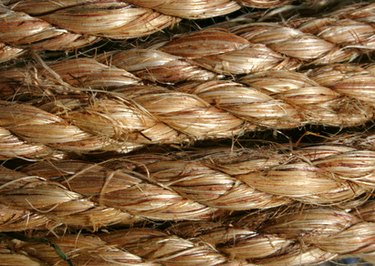Things You'll Need
1-by-6-by-18-inch board
Hand saw
Coping saw
Drill
1/8-inch diameter wire
Wire cutters
Pliers
3 washers
3 cotter pins
1/2-by-3-by-12-inch board
Clamp or angle brace
2-by-12-by-24-inch board
1-inch screw hook

The secret of twisting rope so it will hold together is to twist each individual group of fibers one way, while twisting several sets of fibers together the other way. The two opposite twists work against each other, preventing each from untwisting. The result is a rope that is stronger than the individual fibers. You can turn baling twine or any similar twine into thicker three-strand rope with a homemade rope-making machine made of wood and wire and operated by hand.
Step 1
Saw a 5-inch diameter circle from a 1-inch thick board with a coping saw or jigsaw. Also saw a 1-by-6-inch board 12 inches long with a handsaw or table saw.
Video of the Day
Step 2
Hold the circular board flat against the 12-inch board at one end. Drill three 3/16-inch diameter holes through both boards. Space the holes in a triangle about 1 1/2 inches on each side and center the triangle in the circle. Measurements don't need to be exact; you can estimate them by eye.
Step 3
Cut three pieces of 1/8-inch diameter wire 8 inches long, using wire cutters. Use stiff wire, such as heavy coat hanger wire or fence wire. Bend each piece at a 90-degree angle to the right, 1 1/2 inches from one end, using pliers. Bend it at a 90-degree angle to the left, 2 inches beyond the previous bend.
Step 4
Slip the 1 1/2-inch straight end of one wire through a hole in the circle. Slip a metal washer that has a 3/16-inch hole over the protruding end. Bend the protruding end into a tight loop and add a cotter pin through the loop to anchor the wire through the wood circle. Repeat for the other two wires.
Step 5
Insert the other ends of the wires through the three holes in the 12-inch board. Bend those protruding ends into hooks that will hold looped twine, leaving enough slack between the boards to allow you to rotate the circle and turn the hooks.
Step 6
Saw a 1/2-by-3-inch board 12 inches long. Saw half of it to a taper with a coping saw or jigsaw so you can comfortably hold it like a paddle. Saw three broad U-shaped notches in the other end, about 1 inch wide and 1 inch deep, one in the end of the board and one in each side about 2 inches down from the end. This process makes a roughly Y-shaped tool that you'll use to keep the twine separated as it's being twisted.
Step 7
Choose a flat, open area for a "rope walk." The space should be at least 10 feet long and may be as much as 100 feet, depending on how much clear space you have and how long a rope you want to make. Fasten the 12-inch board vertically at one end of the rope walk at a comfortable height for cranking. The wire hooks should be toward the top and facing the rope walk. You could clamp it to the top board of a fence or attach a metal angle brace to the back and clamp it to a picnic table top.
Step 8
Screw a 1-inch metal hook to the center of a 2-by-4-inch board that's about 2 feet long. Have one person hold this hook and stand at the opposite end of the rope walk from the machine.
Step 9
Thread the machine by tying one end of a length of twine to the hook that the person is holding, bring the twine over to the rope-making machine and loop it on one of the machine's three hooks. Bring it back to the person's hook, loop it over that hook and repeat until each of the machine's hooks has a loop of twine over it. Tie the end of the twine back on the person's hook.
Step 10
Turn the circle of the rope-making machine slowly clockwise while the second person keeps tension on the twine by holding the other hook. Have a third person insert the Y-shaped tool so one strand of twine runs through each notch. She should start near the person holding the hook and they should only move forward as the rope forms, keeping tension on the twine at all times. When all the twine is twisted into rope, slip it off the hooks and tie or whip the ends to keep them from unraveling.
Tip
A rope-making machine made from hardwood will last longer. Softwood will eventually wear where the wires come through.
Add a wooden handle to the circular board to make turning easier.
For heavier rope, thread the machine at the beginning with two or three loops on each hook, rather than one.
Warning
Tie back long hair and watch that loose clothing doesn't get caught in the twisted twine.
Video of the Day